Age II: The Conquerors - The Spaniards Showcase
Our third installment of Age II: Conqueror's civilizations examines the Spanish.
The Spaniards Showcase
The third installment of our five-part look at the civilizations of the Age II expansion, The Conquerors, returns to the Old World to consider the mighty empire of Spain. In the 15th century, around the time covered in the Imperial Age of Age II, Spain vied with Britain to become one of the most influential and farthest-reaching empires of the world. Spain had a unique and tumultuous history, and it was at times a bastion of early western civilization and a victim of Middle Eastern conquest. During different time periods, it was a European power, a conquered Arabian state, a Muslim nation, or an empire serving the Christian God. Its opposing forces combined to create a unique power that is very much the epitome of Age II expansion's name: Conquerors.
The Spanish are among the most versatile civilizations in Age II: The Conquerors, and they have as much leeway in executing strategies as the more advanced Age II civs, like the Chinese and Saracens. They can be played offensively or defensively, as they have good defensive capabilities and excellent offensive units.

The Spaniards figure prominently into the new expansion pack. In fact, they are in two of the four new campaigns in The Conquerors. You can play as the Spaniards in the El Cid campaign or play against them in the Montezuma campaign.

Now, let us take a look at the Spanish Empire, a great nation that is perhaps the most advanced and far-reaching power of The Conquerors expansion set.
History
The great nation of Spain has a long and tumultuous history, divided into three main eras. The first such era covered in the Age of Kings timeline is the conquest of Spain by the Goths. The Goths are one of the raider civilizations in Age of Empires II, and they are fearsome barbarians with a penchant for overrunning enemies with hordes of infantry. Historically, when the Huns drove the Goths west from their homes in Eastern Europe, they split into two tribes and migrated through the European continent. The Visigoths, or West Goths, eventually settled on the Iberian peninsula, wrestling the region away from the Romans, who abandoned their former holdings to the overwhelming Visigoths, who then founded a Christian kingdom.
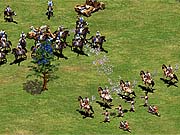

From the 13th century on, the Spanish Christians waged their own crusade against the Muslims, and they eventually forced the fall of Granada at the end of the 15th century. At around the same time, the Spanish monarchy would send Columbus off on his historic voyage to India, wherein he accidentally landed in the Americas and "discovered" the New World for the Europeans.
Spanish Bonuses
The Spanish have some excellent unique advantages that benefit them throughout the ages of the game. They are great at establishing expansions, buildings, and towns. They have easy and cheap access to military upgrades, and, of course, they have a good naval bonus.
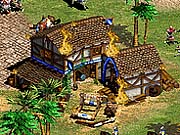
Their most immediate bonus is that the Spanish villagers build faster than other civs' villagers. Specifically, the Spanish construct buildings 33 percent faster than normal. This is immensely helpful, as it lets you expand faster and outdistance your opponents both economically and militarily. During the first age, you can spend less time building those first crucial buildings; thus, you can get a slight advantage in gathering, and you can also produce your first units a little faster. During defensive combats, you can also erect walls and towers faster, meaning you are much better at responding to unexpected attacks. Whereas other civilizations might not have time to build a few extra towers when they see an army amassing at the gate, you can build a few towers and maybe even a castle! Ensemble says that the Spanish can be incredibly aggressive builders, erecting powerful castles at the frontlines or around their towns at alarming speeds.
Blacksmith Upgrades Cost No Gold
Another bonus lets you quickly upgrade your infantry and cavalry, providing a great advantage in the Castle and Imperial Age, especially when the ability to field powerful military units quickly is a must. In the Feudal Age, the blacksmith upgrades do not cost gold, but in the two later ages, the gold cost on upgrades is substantial, and saving all that gold translates into better upgrades for other units or more troops overall. Says Ensemble, "Spanish units tend to be more upgraded compared to other civilizations, and the Spanish can use combined arms more easily since they can afford to upgrade separate lines. Most Spanish players will get all the blacksmith upgrades by the end of the game, which is rare for other civilizations."
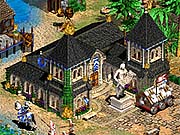
The Spanish armada was a force to be reckoned with during the age of exploration in Europe. Thus, it is natural that the Spanish should have a naval bonus as well. Basically, the free ballistics upgrade means the Spanish galleons have better target tracking so they won't miss as often when firing against land units or fast ships. It is a modest bonus, but it gives the Spanish a sea-to-land attack advantage.
Team Bonus: Trade Cogs and Carts Return 33 Percent More Gold
At Ensemble Studios, general consensus is that the Spanish have the best team bonus. Those who don't use trading to supplement their income will see the error of their ways as soon as they play the Spanish in a team game. By returning 33 percent more gold per trip, the Spanish trade cogs and carts can significantly boost gold income for you. Says Street, "The combination of a Spanish ally and the Caravan upgrade with a map-spanning trade route can literally bring in 10,000 or more gold over the course of a game."
Spanish Units and Technology
The Spanish, like the Vikings, are lucky in that they get two unique units. One is a powerful, mounted hand cannoneer, while the other is a special monk unit. The Spanish also have a unique technology that benefits their villagers, which is combined with the building bonus to create some incredible frontline builders.
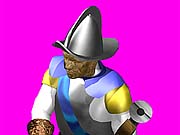
The cavalry conquistador is a mounted hand cannoneer. It has a powerful close attack that, as with other gunpowder units, is inaccurate at long range. The great advantage of this unit is its incredible damage potential and its superior mobility. Although it doesn't have long range, it can provide excellent support for Spanish infantry or cavalry and can rush between engagements quickly. It is good for taking down enemy infantry, monks, elephants, and Teutonic knights, but weak against pikemen and against mounted units that can get close to them, such as knights and camels. The upgrade to the cavalry conquistador is the elite conquistador. Says Street, "The conquistador is a heavy horse archer. They have lots of hit points and armor for a horse archer, and they are only a little slower. Conquistadors in number can defeat almost any other kind of unit, particularly with paladins or missionaries mixed in [for support], although they are weak against buildings. The conquistador's weakness, aside from expense, is that there are plenty of counterunits, from camels to pikemen to skirmishers."
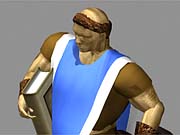
The missionary is the other Spanish unique unit. A donkey-mounted monk, the missionary moves faster than the ordinary monk. However, it cannot see as far, and it has less conversion range. Moreover, missionaries cannot pick up relics. Street says, "The missionary is a mounted monk that trades in a bit of range for enhanced speed. Missionaries are useful in keeping up with and healing fast-moving cavalry units... Monks in general are more common in the expansion, partially because of a few healing-related bugs that are now fixed, partially because relics now bring in more gold than ever, and partially because of new monk-related technologies (theocracy in particular). Missionaries get all the monk upgrades." Although mounted on donkeys, the missionary does not benefit from "cavalry" upgrades. Once you build a castle, the missionary will be available at the monastery.
Supremacy
The unique Spanish technology is called supremacy. What it does is give your villagers combat bonuses and more hit points. Supremacy lets the villagers live longer if they are left unguarded or protected by only a few units. Combined with the faster building bonus, this ability lets the Spanish villager act as an offensive unit that can rush into bases, withstand hits, and erect towers in enemy territory. Although this technology won't be used in every game, it can be very useful in the right circumstances.
Petard
The petard isn't actually a unique Spanish unit, but it is one of the new units available in the Age II expansion. It is a demolition unit that can blow up buildings or, if you are lucky, clusters of units. This unit is best for destroying buildings, towers, and slow-moving siege weapons. However, it is ineffective against units that can outmaneuver it, which is basically all infantry, archers, and cavalry units. Many civilizations, basically those with access to gunpowder, can build this unit.
Spanish Strengths and Weaknesses
The Spanish should prove to be an excellent civilization to play. They have a wide range of technologies available to them, both offensive and defensive strengths, two unique units, and the ability to thrive on both land and island maps.
They have access to all infantry and all cavalry. In fact, the only unit they do not get is the foot archer. The Spanish melee attack strength is formidable, as they can upgrade their infantry up to the champion and halberdier and can acquire paladins. In addition, they get all the infantry and cavalry upgrades, and at discount. Their ranged capabilities are also good - despite their lack of a foot archer, they get cavalry archers, and they have mounted gunpowder units. The Spanish thus can field fast and powerful armies, using any combination of champions, paladins, conquistadors, hand cannoneers, horse archers, halberdiers, and other strong units. On water maps, the Spanish are also well endowed with a wide range of ships, better galleons, and all naval technologies.
What the Spanish don't get are foot archers such as the crossbowman and arbalest, and they are missing a few high-end siege engines, like the siege onager and the heavy scorpion.
Says Street, "The Spanish are very versatile. They are powerful on land and water, and they can build defenses for an early rush or, with their trade bonus, keep making expensive units well after most other players have resorted to cheap pikemen and skirmishers. Perhaps second only to Vikings, Spanish are a good choice when you don't know what the map is going to look like. When I am playing Spanish, I try to keep my opponents guessing. Perhaps I will go for an early tower and monk rush (after all, you will probably want those monk upgrades anyway for the missionaries). Perhaps I will make a few light cavalry or cavalry archers for some Castle Age raiding. Perhaps I will just 'turtle in' with some protective walls and towers and make a huge group of paladins and conquistadors. I could even make a wonder and defend it with quick-building bombard towers. The Spaniards' only weakness is their lack of decent foot archers. Thus, attacking them with lots of infantry can be effective. On the ocean, there is almost nothing you can do except hope you have some Byzantine fire ships or Korean turtle ships on your team."
Of all the civilizations in the new expansion pack, the Spanish seem to be the most superior in terms of flexibility and technology. They are a strong civilization throughout the different ages of the game, they can field strong cavalry and infantry units, and they have dominant strength on the seas. With a major presence in two campaigns in Age of Empires II: The Conquerors, the Spanish seem to be a large focus of the expansion. They should prove to be a worthwhile civilization to play.
Join us two Wednesdays from now, when we turn from the conquerors to the conquered, as we visit the Aztec civilization.
Got a news tip or want to contact us directly? Email news@gamespot.com
Join the conversation